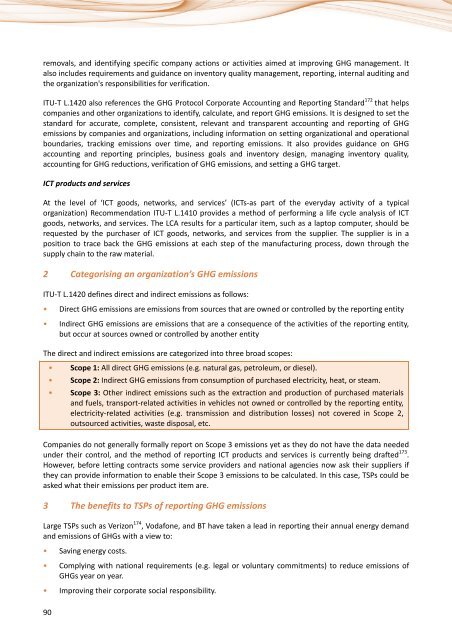Information and communication technologies (ICTs) and ... - ITU
Information and communication technologies (ICTs) and ... - ITU
Information and communication technologies (ICTs) and ... - ITU
Create successful ePaper yourself
Turn your PDF publications into a flip-book with our unique Google optimized e-Paper software.
emovals, <strong>and</strong> identifying specific company actions or activities aimed at improving GHG management. It<br />
also includes requirements <strong>and</strong> guidance on inventory quality management, reporting, internal auditing <strong>and</strong><br />
the organization's responsibilities for verification.<br />
<strong>ITU</strong>-T L.1420 also references the GHG Protocol Corporate Accounting <strong>and</strong> Reporting St<strong>and</strong>ard 172 that helps<br />
companies <strong>and</strong> other organizations to identify, calculate, <strong>and</strong> report GHG emissions. It is designed to set the<br />
st<strong>and</strong>ard for accurate, complete, consistent, relevant <strong>and</strong> transparent accounting <strong>and</strong> reporting of GHG<br />
emissions by companies <strong>and</strong> organizations, including information on setting organizational <strong>and</strong> operational<br />
boundaries, tracking emissions over time, <strong>and</strong> reporting emissions. It also provides guidance on GHG<br />
accounting <strong>and</strong> reporting principles, business goals <strong>and</strong> inventory design, managing inventory quality,<br />
accounting for GHG reductions, verification of GHG emissions, <strong>and</strong> setting a GHG target.<br />
ICT products <strong>and</strong> services<br />
At the level of ‘ICT goods, networks, <strong>and</strong> services’ (<strong>ICTs</strong>-as part of the everyday activity of a typical<br />
organization) Recommendation <strong>ITU</strong>-T L.1410 provides a method of performing a life cycle analysis of ICT<br />
goods, networks, <strong>and</strong> services. The LCA results for a particular item, such as a laptop computer, should be<br />
requested by the purchaser of ICT goods, networks, <strong>and</strong> services from the supplier. The supplier is in a<br />
position to trace back the GHG emissions at each step of the manufacturing process, down through the<br />
supply chain to the raw material.<br />
2 Categorising an organization’s GHG emissions<br />
<strong>ITU</strong>-T L.1420 defines direct <strong>and</strong> indirect emissions as follows:<br />
• Direct GHG emissions are emissions from sources that are owned or controlled by the reporting entity<br />
• Indirect GHG emissions are emissions that are a consequence of the activities of the reporting entity,<br />
but occur at sources owned or controlled by another entity<br />
The direct <strong>and</strong> indirect emissions are categorized into three broad scopes:<br />
• Scope 1: All direct GHG emissions (e.g. natural gas, petroleum, or diesel).<br />
• Scope 2: Indirect GHG emissions from consumption of purchased electricity, heat, or steam.<br />
• Scope 3: Other indirect emissions such as the extraction <strong>and</strong> production of purchased materials<br />
<strong>and</strong> fuels, transport-related activities in vehicles not owned or controlled by the reporting entity,<br />
electricity-related activities (e.g. transmission <strong>and</strong> distribution losses) not covered in Scope 2,<br />
outsourced activities, waste disposal, etc.<br />
Companies do not generally formally report on Scope 3 emissions yet as they do not have the data needed<br />
under their control, <strong>and</strong> the method of reporting ICT products <strong>and</strong> services is currently being drafted 173 .<br />
However, before letting contracts some service providers <strong>and</strong> national agencies now ask their suppliers if<br />
they can provide information to enable their Scope 3 emissions to be calculated. In this case, TSPs could be<br />
asked what their emissions per product item are.<br />
3 The benefits to TSPs of reporting GHG emissions<br />
Large TSPs such as Verizon 174 , Vodafone, <strong>and</strong> BT have taken a lead in reporting their annual energy dem<strong>and</strong><br />
<strong>and</strong> emissions of GHGs with a view to:<br />
• Saving energy costs.<br />
• Complying with national requirements (e.g. legal or voluntary commitments) to reduce emissions of<br />
GHGs year on year.<br />
• Improving their corporate social responsibility.<br />
90

















